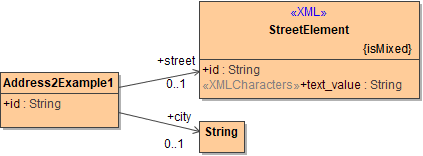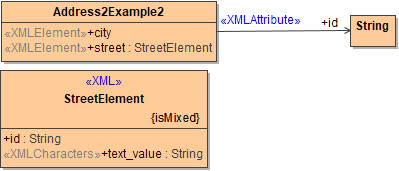The following operations and components are using a built-in mapping of XML to UML classes and vice versa:
-
Components:
-
SOAP Adapter and SOAP Service exchanging document style/literal encoded messages.
The mapping procedures are used, when mapping SOAP messages to UML classes and back.The mapping procedures described below do not work with SOAP/RPC encoding.
-
REST Adapter and REST Service
The mapping procedures are used, when mapping REST calls to UML classes and back.
-
-
Operations:
Mapping of UML classes to XML documents is controlled by stereotypes assigned to class attributes and association ends.
Controlling the Mapping by Using Stereotypes
Stereotypes control how UML class properties (attributes and association ends) are serialized to an XML document. If no stereotype is assigned, the following default rules apply for mapping XML to UML classes:
-
XML attributes are mapped to class attributes.
-
XML elements are mapped to class associations ends.
-
The XML root element is named according to the definitions in the service composite, tagged value Class To XML Default Root Name (also see Frontend Components).
Stereotypes
To control the mapping, the following stereotypes are available:
|
Stereotype |
Description |
Tagged Values
|
|---|---|---|
|
Class |
||
|
<<XML>> |
Set this basic stereotype on class level to be able to apply the stereotypes listed below to the attributes. You can only apply one of these stereotypes at a time. |
xmlNamespace
|
|
Attribute |
||
|
All stereotypes listed below inherit from <<E2EAttribute>> which gives additional tagged values. In this context of XML-UML mapping, only externalName and order are relevant. |
externalName
|
|
|
<<XMLNamespace>> |
When this stereotype is applied to an UML property, it will be mapped to a XML namespace. The property must be of base type String.
|
|
|
<<XMLElement>> |
When this stereotype is applied to an UML property, it will be mapped to an XML element. |
xmlNamespace
|
|
<<XMLAttribute>> |
When this stereotype is applied to an UML property, it will be mapped to an XML attribute. The property must be of simple type. If the property type is complex, the compiler will report an error. |
xmlNamespace
|
|
<<XMLCharacters>> |
When this stereotype is applied to an UML property, its content will be mapped to a character stream. The property must be of simple type. |
xmlFormat
|
Tagged Values
|
Tagged Value |
Stereotype |
Description |
Allowed Values |
|
|---|---|---|---|---|
|
Classes |
||||
|
classToXMLDefaultRootName |
<<E2EComposite>> |
Bridge 7 Specify which name to assign to the XML root element upon serializing. This setting can be overridden by using XML composer options as described on (25.3) classToXML() Operation. If this tagged value is set to other values than "Default", tagged values xmlElementName and xmlNamespace on the <<XML>> class are disregarded.
|
Default |
Try to use name and namespace defined on the class by the <<XML>> stereotype. Fallback to Variable Name if not provided (default). |
|
Type Name |
Use static name and namespace of the class as name of XML root element. |
|||
|
Variable Name |
Use the name of the reference (object/variable) as name of XML root element. |
|||
|
xmlNamespace |
<<XML>> |
Specify the XML namespace. |
a valid namespace |
|
|
xmlElementName |
<<XML>> |
Specify the name of the XML root element. |
a valid element name |
|
|
isMixed |
<<XML>> |
Specify whether the XML contains attributes that are serialized as character stream (attributes with stereotype <<XMLCharacters>>, see also XML - UML Class Mapping | id (25.3)XML UMLClassMapping ControllingtheMappingbyStereotypes).
|
true |
XML contains serialized attributes. |
|
false |
XML does not contain serialized attributes (default). |
|||
|
isOrdered |
<<XML>> |
Specify whether the class attributes should be serialized to XML using the order tag that has been specified on the attributes. |
true |
Serialize in order of order tags from the attributes. |
|
false |
Serialize in order of attributes on class (default). |
|||
|
Attributes |
||||
|
xmlNamespace |
<<XMLElement>>
<<XMLAttribute>> |
Each XML attribute and element may have its own namespace. If the tagged value contains an URI, the runtime will automatically generate a unique prefix. Examples:
|
an URI |
|
|
a valid xlmns syntax |
||||
|
xmlForm |
<<XMLElement>>
<<XMLAttribute>> |
Depending on this tagged value, XML elements or attributes may not be qualified by a namespace prefix even if they have one. |
qualified |
The element or attribute must always be qualified by a namespace prefix. Default for XML elements. |
|
unqualified |
No namespace prefixes are allowed (for details see http://www.w3.org/TR/xmlschema-0/#NS ). Default for XML attributes. |
|||
|
xmlFormat |
<<XMLElement>>
<<XMLAttribute>>
|
If numbers and date/time types are parsed or composed, the XML parser respectively composer expects simple date types following the XML schema specification. However, legacy XML documents may contain different number and date/time formats. In this case, the tagged value xmlFormat may hold a format string.
|
a valid format string (see Number Formattingor Date and Time Formatting) |
|
|
CDATA |
compose string as CDATA |
|||
|
isNillable |
<<XMLElement>> |
By default, UML properties that are NULL are not serialized into XML documents. However, if it is necessary to do so, isNillable must be set to true. In this case, the UML properties being NULL will look like: Some client code generators will use this attribute in the WSDL file for type generation. If false they will generate simple types, if true they will generate complex types.
|
true |
serialize NULL properties |
|
false (default) |
do not serialize NULL properties |
|||
|
order |
<<XMLNamespace>>
|
Use order to specify the order in which the XML elements will be generated to the XML document. |
a valid float |
|
|
externalName |
<<XMLNamespace>>
|
Sometimes names of XML attributes or elements do not comply with the rules specified on Syntax Scheme of the xUML Action Language. Use externalName to specify the name of the XML attribute or element, and specify a better name via the name of the UML property for internal usage. |
|
|
Examples
Mapping Mixed Content XML to a UML Class
The following example shows how to convert an XML data structure with mixed content to an UML class.
If an XML element has attributes, this is called mixed content in Bridge context.
Suppose the following XML data structure with two elements street and city is given:
<address id="4711">
<street id="4711-1">13, Coal Street</street>
<city id="4711-2">New York, NY 10017, USA</city>
</address>
The class diagram below illustrates how to map the content of XML element street ("13, Coal Street") and the value of its attribute id ("4711-1") to a class structure:

To map XML element street and its attribute id, you need a dedicated class as a container. In this example, this is class StreetElement. XML attribute id of element street is mapped to class attribute id of UML class StreetElement via matching names. The content of the XML element street is mapped to the class attribute that has stereotype <<XMLCharacters>>. In this example this is text_value.
Class StreetElement must have stereotype <<XML>> and tagged value isMixed set to true because it contains the serialized attribute text_value (also see explanation of tagged value isMixed ).
Containter StreetElement is associated to the main address class. The name of the association end (street) must match the name of the XML element. Associated class StreetElement is only a container for the street element and its name is not relevant for the mapping.
If the XML element contains attributes, which should not be mapped to UML class attributes, an association to a base type can be used. The example shows this for element city . The content of the element ("New York, NY 10017, USA") will be available in city (accessible as attribute of the instantiated class Address2Example1). As the id attribute cannot be mapped, it will be discarded when executing xmlToClass() .
If an object of class Address2Example1 was serialized back to a SOAP response, the SOAP message would read:
<address2Example1 xmlns:ns1="urn:Services.URLService.URLPort.DataItems" xsi:type="ns1:Address2Example1">
<id xsi:type="xsd:string">4711</id>
<street xsi:type="ns1:StreetElement">
<id xsi:type="xsd:string">4711-1</id>
<text_value xsi:type="xsd:string">13, Coal Street</text_value>
</street>
<city xsi:type="xsd:string">New York, NY 10017, USA</city>
</address2Example1>
The same result could be obtained with the following class diagram:

You have the flexibility to map XML structures in different ways. You can define very compact class diagrams for simple XML structures, but you have also the possibility to map complex XML data structures graphically.
If an XML Schema is provided, you can import it with the Builder. It will generate all classes and relations according the XSD import rules described in XML Schema Import Rules. For how to use the XSD Importer refer to Importing WSDL or XSD.
Arrays and XML Serialization
The behavior of XML serialization in this case is not always self-explanatory but a consequence of the definition of arrays in XML schema.
The following table shows the behavior of XML serialization for the following class containing an array:

{
"aClass" : { "anArray" : ["A1", "A2", "A3"] };
}
|
Description |
XML result |
|---|---|
|
All values are present. |
XML
|
|
The second value (A2) is NULL and isNillable=false. |
XML
|
|
The second value (A2) is NULL and isNillable=true |
XML
|
|
The array is NULL. |
XML
|
|
The array is empty. |
XML
|
|
All elements are NULL and isNillable=false. |
XML
|
|
All elements are NULL and isNillable=true. |
XML
|
|
classToXMLDefaultRootName="Default" and xmlElementName="anotherClass". |
XML
|
|
classToXMLDefaultRootName="Type Name" and xmlElementName="anotherClass". |
XML
|
|
classToXMLDefaultRootName="Variable Name" and xmlElementName="anotherClass". |
XML
|
